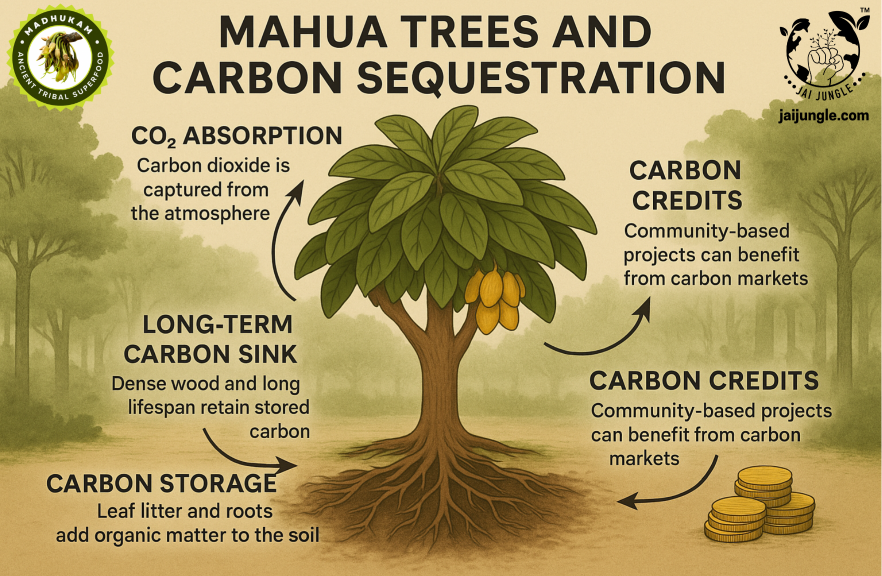The Carbon Connection: Why Trees Like Mahua Matter
Forests are Earth’s natural carbon banks—absorbing atmospheric carbon dioxide (CO₂) and storing it as organic matter. Among India’s native forest trees, Mahua (Madhuca longifolia) stands out as both an ecological and economic asset.
Its dense wood, deep roots, and long lifespan make it an exceptional carbon-sequestering species, while its flowers and seeds provide year-round livelihood security. This unique combination means Mahua supports both climate mitigation and rural resilience, bridging ecology and economy.
Biomass and Carbon Storage Potential
A mature Mahua is a substantial organism—often 15–20 meters tall, with a broad crown and a trunk exceeding a meter in diameter (World Agroforestry, ICRAF 2019).
Because wood is roughly 50% carbon by dry mass, Mahua’s large biomass equates to significant carbon storage.
Carbon Content Estimates:
| Tree Parameter | Estimated Value | Source / Reference |
|---|---|---|
| Average carbon stored in a mature Mahua | ~300 kg C per tree | IJ Plant & Environment, 2021 |
| Upper range (very large Mahua) | up to 1,000 kg C | ResearchGate, 2022 |
| Biomass carbon per hectare in Mahua forest | ~50 tons C/ha | ScienceDirect, 2020 |
These figures place Mahua among the top carbon-storing native trees in central and eastern India’s deciduous forests.
A single large Mahua can thus lock away hundreds of kilograms of carbon, equivalent to several tons of CO₂ removed from the atmosphere over its lifetime.
Annual Sequestration Rates: Understanding the Numbers
While some literature ambiguously reports high values (e.g., “94 tC/yr”), these likely refer to per-hectare or ecosystem-level data.
Realistically, a growing Mahua sequesters about 3–5 kg of carbon per year, or 10–20 kg of CO₂, during its main growth phase.
That may seem small individually, but across hundreds of trees—or a Mahua agroforest—it scales impressively.
Example:
A community planting 1,000 Mahua trees could, at maturity, store roughly 5,000 tons of CO₂ equivalent, depending on tree density and management.
Deep Roots and Soil Carbon: The Hidden Reservoir
Mahua’s climate benefit extends underground. Its deep taproot and extensive lateral roots increase soil carbon storage through:
- Leaf litter decomposition: Tannin-rich leaves decompose slowly, building humus and stabilizing soil organic matter.
- Root turnover: Dead roots contribute carbon to deep soil layers, where it can persist for decades.
- Flower and fruit fall: Organic residues enrich the topsoil carbon pool.
In many ecosystems, soil organic carbon surpasses aboveground biomass carbon. Mahua contributes to both—enhancing fertility while storing atmospheric carbon safely underground.
(World Agroforestry, 2019)
Longevity: Long-Term Carbon Storage
Mahua trees can live for 80–100 years, effectively locking away carbon for generations.
When the wood is used for durable goods like furniture, house beams, or carts, the carbon remains stored even after harvest—unlike when used as firewood, which releases carbon back into the air quickly.
This underscores the principle of “carbon permanence”—maximizing storage duration by promoting non-destructive Mahua use (flowers, seeds, oil) rather than felling trees for wood.
Reforestation and Agroforestry with Mahua
Mahua is ideal for reforestation, restoration, and agroforestry programs because:
- It is multi-functional (food, oil, fodder, fertilizer).
- It thrives in semi-arid and degraded soils.
- Farmers value it, reducing the risk of premature felling.
This makes Mahua a socially secured carbon sink—unlike fast-growing exotic trees that may be cut for timber.
“A tree that feeds you every year is rarely cut down.”
That principle gives Mahua a strategic role in community-led carbon sequestration projects.
Mahua and Carbon Credits: From Forest to Finance
Under voluntary and compliance carbon credit systems, communities can be paid for the carbon their trees store.
If one Mahua tree at maturity holds ~5 tons CO₂ equivalent, then:
- 1,000 trees = 5,000 tons CO₂ eq sequestered.
- At $10/ton CO₂, this equals $50,000 in potential carbon value (long-term).
However, actual participation requires Monitoring, Reporting, and Verification (MRV) of tree growth and survival.
Projects under REDD+, Afforestation/Reforestation (A/R), or Voluntary Carbon Markets could include Mahua within community-based carbon programs.
(ARCC Journals, 2022; ResearchGate, 2023)
Comparative Carbon Value
Studies comparing Indian native species under Miyawaki plantations and natural forests found Mahua among the top biomass accumulators.
| Study Context | Mahua Carbon Stock | Notes |
|---|---|---|
| ARCC Journal (2022) | 250,533 kg/ha (approx.) | Highest in dense plantation trial |
| ScienceDirect (2020) | ~50 t C/ha | Comparable to Sal and Terminalia species |
| ResearchGate (2022) | 19,944 kg/tree (likely misreported) | Indicates high potential biomass |
While numerical precision varies, the trend is clear—Mahua ranks among India’s best native carbon-storing species.
Resilience: Keeping Carbon Secure
Carbon stored in forests is only valuable if it stays locked.
Mahua is naturally resilient to many disturbances:
- Fire tolerance: Its thick bark and deciduous habit reduce fire intensity and aid regrowth.
- Pest resistance: It rarely suffers mass die-off events.
- Drought survival: Ensures continued carbon gain even under stress.
Hence, Mahua offers stable, low-risk carbon storage in a warming, uncertain climate.
Co-Benefits Beyond Carbon
Every ton of carbon stored by Mahua also generates climate co-benefits:
- Local cooling through canopy shade and transpiration.
- Improved water retention and soil fertility.
- Habitat for pollinators and biodiversity.
- Sustainable harvests of non-timber forest produce.
Thus, carbon sequestration through Mahua is both mitigation and adaptation in one system—a natural climate solution that sustains life and livelihoods.
Communicating the Value
To visualize Mahua’s contribution:
- One Mahua tree growing over 50 years could offset about 2.5 tons of CO₂, roughly the emissions from a small car driving 10,000 km.
- A Mahua forest of 100 trees could offset the annual emissions of an average household in India.
While these numbers are illustrative, they make carbon tangible for communities and policymakers alike.
Conclusion
By linking traditional livelihood trees with climate mitigation strategies, Mahua offers a path toward “carbon-smart livelihoods.”
Each Mahua planted is both a carbon sink and a food source, aligning economic benefit with environmental stewardship.
In the climate economy of the future, trees like Mahua are not just natural resources—they are natural assets.
Integrating Mahua into carbon projects ensures that rural prosperity and global climate goals grow hand in hand.
References and Data Sources
- World Agroforestry (ICRAF). (2019). Madhuca longifolia Tree Database. https://apps.worldagroforestry.org
- Indian Journal of Plant and Environment. (2021). “Carbon Storage Potential of Native Deciduous Trees.” https://ijplantenviro.com
- ARCC Journals. (2022). “Tree Carbon Biomass Assessment under Miyawaki Model.” https://arccjournals.com
- ScienceDirect. (2020). “Biomass and Carbon Estimation of Indian Dry Deciduous Forests.” https://sciencedirect.com
- ResearchGate. (2022). “Carbon Sequestration Rates of Agroforestry Tree Species.” https://researchgate.net

